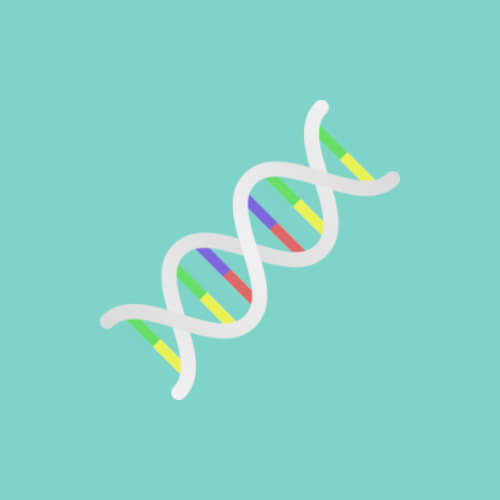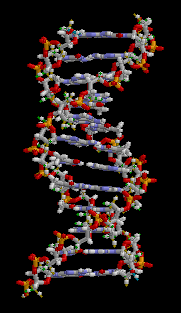



DNA, short for deoxyribonucleic acid (dee-oxy-rye-bo-new-clay-ick aa-sid), is the complex molecule responsible for carrying the genetic information of living cells. DNA is found in almost all living things on Earth with the small exception of a few viruses and bacteria that use RNA, a molecule similar to DNA. DNA is passed on during cell division and replication, resulting in the sharing of genetic traits with daughter cells and offspring.
DNA has a unique shape in the world of molecules, sort of like a twisted ladder. The sides of the ladder twist upwards, with smaller molecules called nucleotides forming the ladder rungs, or bars, in between. This special structure is called a double helix.
Each nucleotide is made up of three parts: a sugar molecule called deoxyribose, a phosphate group, and one of four different nitrogen-containing bases: adenine (A), thymine (T), cytosine (C), and guanine (G). Adenine always pairs with thymine, and cytosine always pairs with guanine.
The discovery of DNA's double helix structure was a remarkable achievement in the 1950s, led by James Watson and Francis Crick. They, along with the contributions of Rosalind Franklin and Maurice Wilkins, played key roles in unraveling the mystery of DNA. Using X-ray crystallography data obtained by Franklin and Wilkins, as well as their own creative thinking, Watson and Crick pieced together the puzzle of DNA's structure.
In 1953, Watson and Crick proposed the double helix model for DNA, a breakthrough that revolutionized our understanding of genetics. Their model also revealed the specific rules that control how DNA's information is stored and coded, explaining how DNA carries and transmits genetic information accurately during cell division and reproduction. Their discovery has had an enormous impact on scientific research and earned them the Nobel Prize in Physiology or Medicine in 1962, along with Maurice Wilkins.
Genetic information is stored within DNA molecules in sequences of nucleotides known as genes. Genes provide instructions for producing proteins, which are necesessary for growth, repair, and other various functions of cells.
Biologists estimate that humans have around 20,000 to 25,000 genes, each responsible for a different protein. These proteins work together to carry out the complex processes that make our bodies function.
Each gene is like a coded recipe where its ingredient are amino acids, the building blocks of proteins. Genes instruct which amino acids to use by representing them with three-nucleotide codes called codons. For instance, the codon "CCT" (cytosine-cytosine-thymine) is an instruction for the amino acid proline.
With four different nucleotide options grouped into three, there are a total of 64 possible codons. Although there are actually over 100 different amino acids in nature, living organisms only use 20. These are known as "essential amino acids." Some amino acids have multiple codons, and three codons tell when the instructions are finished.
Agar, a jelly-like substance derived from a species of red algae, is commonly used in scientific laboratories. It provides a solid surface for growing bacteria and other microorganisms, making it useful for DNA analysis, cloning, and genetic engineering.
Interestingly enough, agar is not only limited to scientific applications. It is also commonly used in the food industry, particularly in the creation of certain candies, such as jellybeans and gummy bears!
They do this by looking at certain parts of our DNA that are more common in specific groups of people. By comparing a person's DNA to a big database, they can make a guess about the regions our ancestors likely lived in. This helps us learn about our family history and how we are connected to different parts of the world.
Today, several popular websites such as ancestry.com and 23andme.com allow you to submit your own DNA for testing. By sending in a mouth swab sample with your saliva (which contains your DNA!), you can trace your own genetic makeup and family history.
Every person on Earth has different DNA, with the exception of identical twins. Using this fact, detectives are able to use any DNA left at crime scenes to help provide clues and solve crimes. This is part of what's called forensic analysis, or using science to help solve crimes.
The DNA in our cells exists as long, linear molecules and is organized into 23 pairs of chromosomes within the nucleus of most cells in the body. If the DNA of one of these cells was unraveled and stretched out, it would measure around 2 m (6.6 ft) in length! This measurement applies to the DNA in a single cell, and it takes into account the tightly coiled and condensed structure of DNA within the cell nucleus.